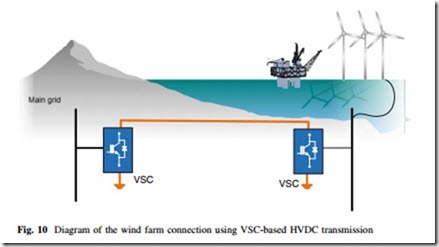Voltage Source Converter for HVDC Transmission in Offshore Wind Energy
Voltage source converter (VSC)-based HVDC transmission uses self-commutated devices. The latest converters are built using series IGBT with antiparallel diodes; however, they can be built using gate turn-off thyristors (GTO) or Integrated gate- commutated thyristors (IGCT). The commutation can be achieved independently of the AC system so the operation differs considerably from those based on LCC. A VSC is shown in Fig. 9.
The main advantages of this type of converter are:
• External commutating source voltage is not required for the proper operation. Contrary to LCC-based HVDC systems which are unable to operate without an AC voltage for the commutation.
• IGBTs or similar work in a higher switching frequency range, so there is with much lower harmonic distortion in VSC-based than LCC-based HVDC systems, though with higher power losses.
The ability to have independent control of active and reactive power. LCCs need passive filters to supply the reactive power demand intrinsic to their operation.
• VSC is able to supply passive grids. This feature is important for the integration of OWF since is related with the start-up capability and the ability to establish an AC grid.
• Reduced footprint compared with LCC-based HVDC systems. The large foot- print in LCC systems is caused by AC filtering that is needed for proper operation.
The cost and switching losses in this type of converter are higher than in a line- commutated converter. However, its high controllability compensates these drawbacks. Active and reactive power can be controlled in the converter and therefore, power quality issues are reduced. Therefore, the converter itself can be used to maintain unity power factor or for reactive power injection to the grid.
Most of the research on the grid integration of OWF using HVDC has been focused on the VSC HVDC [21] which is shown in Fig. 10. Some papers have focused on the economic feasibility [22]. In [14] a comparison of AC and DC transmission options is presented. It is concluded that the VSC-based HVDC is the more affordable option when the OWF is above 100 MW and it is located to more than 90 km. Several others have been focused in the control strategies [23–26]. Some papers have been focused on the impact on the power systems [27]. The use of multiterminal configurations have been extensity studied [28–33]. Many papers have been studied the fault response of the VSC [10, 32, 34].

